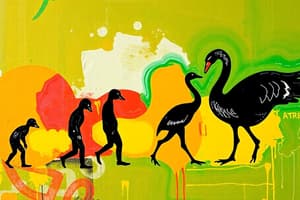Podcast
Questions and Answers
Which primary model parameter describes the duration microbes take to adjust to a new environment before exponential growth?
Which primary model parameter describes the duration microbes take to adjust to a new environment before exponential growth?
- Maximum population density (Ymax)
- Lag phase (λ) (correct)
- Maximum growth rate (μmax)
- Asymptote (A)
A food manufacturer wants to predict the shelf life of a new product. If they choose to describe changes in microbial concentration over time under specific storage conditions, which modeling approach are they using?
A food manufacturer wants to predict the shelf life of a new product. If they choose to describe changes in microbial concentration over time under specific storage conditions, which modeling approach are they using?
- Descriptive Statistics
- Primary Modeling (correct)
- Secondary Modeling
- Inferential Statistics
Which of the following best describes the Baranyi & Roberts model's approach to modeling microbial growth?
Which of the following best describes the Baranyi & Roberts model's approach to modeling microbial growth?
- Using a semi-mechanistic, biologically based approach that includes lag and exponential phases. (correct)
- Focusing solely on the exponential growth phase.
- Ignoring the impact of cell physiology on growth.
- Assuming environmental conditions have no effect on microbial growth.
A researcher observes that a microbial culture's growth rate slows down as toxic metabolites accumulate. Which model is the most appropriate for describing this scenario?
A researcher observes that a microbial culture's growth rate slows down as toxic metabolites accumulate. Which model is the most appropriate for describing this scenario?
A new antimicrobial packaging is being tested; it impacts the time required for cells to adapt to a food product. Which parameter would be most affected by this innovation?
A new antimicrobial packaging is being tested; it impacts the time required for cells to adapt to a food product. Which parameter would be most affected by this innovation?
In the Buchanan model, when is the growth rate considered to be at its maximum?
In the Buchanan model, when is the growth rate considered to be at its maximum?
What is the initial step in developing a primary model for microbial growth in a food product?
What is the initial step in developing a primary model for microbial growth in a food product?
A food scientist wants to model microbial growth using a tool that can be used both online and as an Excel add-in. Which of the following is most suitable?
A food scientist wants to model microbial growth using a tool that can be used both online and as an Excel add-in. Which of the following is most suitable?
What does the coefficient of determination (R²) indicate in the context of growth modeling?
What does the coefficient of determination (R²) indicate in the context of growth modeling?
A company models microbial growth in a static environment. What is a potential limitation when applying this model to real-world food systems?
A company models microbial growth in a static environment. What is a potential limitation when applying this model to real-world food systems?
How do primary models describe microbial growth?
How do primary models describe microbial growth?
Which assumption underlies primary growth models when describing microbial growth?
Which assumption underlies primary growth models when describing microbial growth?
A shorter lag phase (λ) in the Baranyi & Roberts model indicates:
A shorter lag phase (λ) in the Baranyi & Roberts model indicates:
What is a key characteristic of the Gompertz model's description of microbial growth?
What is a key characteristic of the Gompertz model's description of microbial growth?
Which factor primarily influences the momentary microbial growth rate in the Logistic model?
Which factor primarily influences the momentary microbial growth rate in the Logistic model?
In the Buchanan model, what are the two periods into which the lag phase is divided?
In the Buchanan model, what are the two periods into which the lag phase is divided?
What is the role of statistical analysis in developing a primary model?
What is the role of statistical analysis in developing a primary model?
During which step of primary model development are microbial plaque counts transformed into decimal logarithmic values?
During which step of primary model development are microbial plaque counts transformed into decimal logarithmic values?
What does DMFit seek to achieve in fitting microbial curves?
What does DMFit seek to achieve in fitting microbial curves?
Why might predictions made outside the experimental ranges of developed models be considered ‘insecure’?
Why might predictions made outside the experimental ranges of developed models be considered ‘insecure’?
Flashcards
Primary Models
Primary Models
Changes in microbial concentration over time, under specific environmental conditions.
μmax
μmax
Maximum growth rate in primary models.
Lag Phase (λ)
Lag Phase (λ)
Initial adjustment period of microbial growth.
Maximum Population Density (Ymax)
Maximum Population Density (Ymax)
Signup and view all the flashcards
Baranyi & Roberts Model
Baranyi & Roberts Model
Signup and view all the flashcards
Gompertz Model
Gompertz Model
Signup and view all the flashcards
Logistic Model
Logistic Model
Signup and view all the flashcards
Buchanan Model
Buchanan Model
Signup and view all the flashcards
DMFit of ComBase
DMFit of ComBase
Signup and view all the flashcards
R² (Coefficient of Determination)
R² (Coefficient of Determination)
Signup and view all the flashcards
Study Notes
Primary Models for Microbial Growth
- Primary growth models describe changes in microbial concentration over time under specific environmental conditions.
- These models assume a sigmoidal growth function.
- The three main parameters that describe the function are: maximum growth rate (µmax), lag phase (λ), and maximum population density (Ymax).
- The maximum (specific) growth rate (µmax) refers to the change in population over time, measured in h⁻¹.
- The lag phase (λ) has units of hours (h).
- Nmax is the maximum population density.
- Several primary models can describe microbial growth in food, each with its advantages and specifications.
- The models are created and developed based on different theories and hypotheses.
- Examples of models include: Baranyi and Roberts Model, Gompertz Model, Logistic Model, and Buchanan Model.
Baranyi & Roberts Primary Model
- This is a semi-mechanistic, biologically-based growth model that includes an exponential linear growth phase and a lag phase.
- The duration of the lag phase depends on the cell's physiology and its adaptation to the new environment, extending if cells are not well-adapted.
- This model is widely used in predictive microbiology because of its goodness of fit and biologically interpretable parameters.
Gompertz Primary Model
- It is is a double exponential function that describes an asymmetrical sigmoidal curve.
- The model is based on limitations of space and/or nutrients, along with the production of toxic metabolites in conditions where the growth rate is not constant.
- The maximum speed of exponential growth is determined at the inflection point of the curve.
Logistic Primary Model
- The logistic model is a sigmoidal curve that describes microbial growth as a function of initial population, time, growth rate, and final population.
- It relies on the momentary microbial growth rate, which is proportional to the size of the population and the material resources in the environment
Buchanan Primary Model
- Proposed a three-phase linear model that is both sigmoid and mechanistic.
- In this model, the growth rate is always at its maximum between the end of the lag phase and the start of the stationary phase.
- The lag phase consists of new conditions adaptation and the time of energy generation for cell replication.
Developing a Primary Model
- First, obtain growth data from microbiological analysis of a sample such as artificial culture media or studied food, using plate counts.
- Next, graphically represent the growth curve of the microorganism as a function of time using the microbial count data.
- Select and fit the primary model to the experimental data to obtain the microbial growth parameters.
- Lastly, perform a statistical analysis.
Primary Growth Modelling (DMFit of ComBase)
- DMFit fits microbial curves with a linear phase between the lag phase and stationary phase.
- It visualizes microbiological growth data and fits a growth model to the data.
- Microbial curves can be fitted to two types of models.
- A free tool is available in two versions: online (DMFit of ComBase) and offline (DMFit add-in for Excel).
- The online version is used in steps to fit microbial growth models to experimental data.
- The tools can determine statistical indexes based on the coefficient of determination (R²) and the standard error of fit (SE of fit).
- Estimated values may vary for growth parameters and statistical analysis.
- R² (coefficient of determination) measures the goodness of fit of a model.
- It is a statistical measure of how well the regression line approximates the actual data.
Challenges
- Mathematical models have limitations such as, models fit the observed data, so they cannot be extrapolated outside of derived ranges.
- Predictions outside of the experimental ranges can be inaccurate and insecure.
- Models are typically conducted in laboratory media, predicting faster growth rates than in food.
- It causes fail-safe results when validated in food, may not have widespread application.
- Models derived in static conditions may not apply to fluctuating ones.
Studying That Suits You
Use AI to generate personalized quizzes and flashcards to suit your learning preferences.


